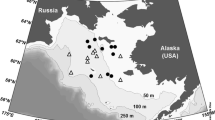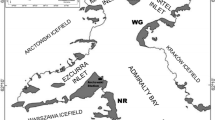Summary
A distinct fauna consisting mainly of nematodes, harpacticoid and cyclopoid copepods, rotifers, turbellarians and polychaete larvae, inhabits the lower levels of the sea ice in Frobisher Bay. Similar faunas are found throughout circumpolar regions. Thirteen taxa of the Frobisher Bay ice fauna were entirely herbivorous. Their food consisted of 26 genera of algae dominated by Chlamydomonas, Nitzschia, Navicula and Chaetoceros. There was a clear tendency to feed on the most abundant ice algae, hence little evidence of selective feeding. High algal food concentrations in the ice (estimated at 5000 μg C/l) were in sharp contrast with the scant nourishment available from phytoplankton under the ice (8 μg C/l) from mid-winter until the start of the summer bloom. Algal stocks and estimated productivity rates indicate that ice meiofaunal food requirements may be met by the ice algae. All the major ice meiofaunal species are well adapted to feeding within the ice. All are small enough to enter brine channels and secure particulate prey from surfaces within confined spaces. The ice meiofaunal species are major consumers of the ice algae and therefore important links in the transfer of energy from the ice to pelagic and benthic predators, including fishes, birds and mammals.
Similar content being viewed by others
References
Alexander VR, Horner R, Clasby RC (1974) Metabolism of arctic sea ice organisms. University of Alaska, Inst Mar Sci Rep R74-4, 120 pp
Andriashev AP (1968) The problem of the life community associated with the antarctic fast ice. In: Currie RI (ed) Proc Symp Antarct Oceanogr. Scott Polar Res Inst Cambridge, pp 147–157
Anraku M, Omori M (1963) Preliminary survey of the relationship between the feeding habit and the structure of the mouth-parts of marine copepods. Limnol Oceanogr 8:116–126
Apollonio S (1965) Chlorophyll in arctic sea ice. Arctic 18:118–122
Arashkevich YG (1969) The food and feeding of copepods in the north-western Pacific. Oceanology 9:695–709
Brain H, Sekerak AD (1978) Aspects of the biology of arctic cod, Boreogadus saida, in the central Canadian Arctic. Report by LGL Ltd, Toronto, for Polar Gas Project, Toronto, 104 pp
Barnard JL (1959) Epipelagic and under-ice amphipods of the central arctic basin. Scientific studies at Fletcher's Ice Island, T-3 (1952–1955), vol 1, pp 115–152
Boaden PJS (1964) Grazing in the interstitial habitat: a review. In: Crisp DJ (ed) Grazing in terrestrial and marine environments. Oxford, pp 299–303
Bradstreet MSW (1977) Feeding ecology of sea birds along fast-ice edges in Wellington Channel and Resolute Passage, NWT. Report by LGL Ltd, Toronto, for Polar Gas Project, Toronto, 149 pp
Bradstreet MSW, Cross WE (1982) Trophic relationships at high arctic ice edges. Arctic 35:1–12
Carey AG Jr (1985) Marine ice fauna: arctic In: Horner RA (ed) Sea ice biota. CRC Press, Boca Raton Florida, pp 173–190
Carey AG, Boudrias MA (1987) Feeding ecology of Pseudalibrotus (= Onisimus) litoralis Kroyer (Crustacea: Amphipoda) on the Beaufort Sea inner continental shelf. Polar Biol 8:29–33
Carey AG, Montagna PA (1982) Arctic sea ice faunal assemblage: first approach to description and source of the underice meiofauna. Mar Ecol Prog Ser 8:1–8
Chengalath R (1985) The Rotifera of the Canadian arctic sea ice, with description of a new species. Can J Zool 63:2211–2218
Conover RJ, Herman AW, Prinsenberg SJ, Harris LR (1986) Distribution of and feeding by the copepod Pseudocalanus under fast ice during the arctic spring. Science 232:1245–1247
Craig PC, Griffiths WB, Haldorson L, McElderry H (1982) Ecological studies of arctic cod (Boreogadus saida) in Beaufort Sea coastal waters, Alaska. Can J Fish Aquat Sci 39:395–406
Eide LI, Martin S (1975) The formation of brine drainage features in young sea ice. J Glaciol 14:137–152
English TS (1961) Some biological oceanographic observations in the central north polar sea, Drift Station Alpha, 1957–58. Arctic Institute of North America, Research Paper 13, 79 pp
Grainger EH (1971) Biological oceanographic observations in Frobisher Bay. II. Zooplankton data, 1967–1970. Fish Res Board Can, Techn Rep 266:61 pp
Grainger EH, Hsiao SIC (1982) A study of the ice biota of Frobisher Bay, Baffin Island 1979–1981. Can MS Rep Fish Aquat Sci 1647:104
Grainger EH, Hsiao SIC, Pinkewycz N, Mohammed AA, Neuhof V (1985a) The food of ice fauna and Zooplankton in Frobisher Bay. Can Dat Rep Fish Aquat Sci 558:67 pp
Grainger EH, Mohammed AA, Lovrity JE (1985b) The sea ice fauna of Frobisher Bay, arctic Canada. Arctic 38:23–30
Hicks GRF, Coull BC (1983) The ecology of marine meiobenthic harpacticoid copepods. Oceanogr Mar Biol Annu Rev 21:67–175
Horner R (1985) Ecology of sea ice microalgae. In: Horner RA (ed) Sea ice biota. CRC Press, Boca Raton Florida, pp 83–103
Horner R, Alexander V (1972) Algal populations in arctic sea-ice: an investigation of heterotrophy. Limnol Oceanogr 17:454–458
Horner R, Murphy D (1985) Species composition and abundance of Zooplankton in the nearshore Beaufort Sea in winter-spring. Arctic 38:201–209
Hoshiai T, Tanimura A, Watanabe K (1987) Ice algae as food of an antarctic Zooplankton in the nearshore Beaufort Sea in winter-spring. Arctic 38:201–209
Hsiao SIC (1987) Sedimentation in arctic Canada: species composition and biomass of phytoplankton contributed to the sediments in Frobisher Bay. Polar Biol 7:245–251
Hsiao SIC (1988) Spatial and seasonal variations in primary production of sea ice microalgae and phytoplankton in Frobisher Bay, arctic Canada. Mar Ecol Prog Ser 44:275–285
Hyman LH (1951) The invertebrates, vol 3, McGraw Hill, Toronto, 572 PP
Itoh K (1970) A consideration on feeding habits of planktonic copepods in relation to the structure of their oral parts. Bull Plankt Soc Jpn 17:1–10
Kern JC, Carey AG Jr (1983) The faunal assemblage inhabiting seasonal sea ice in the nearshore Arctic Ocean with emphasis on copepods. Mar Ecol Prog Ser 10:159–167
Kesteven GL (1978) The southern ocean. In: Borgese EM, Ginsburg N (eds) Ocean yearbook, vol 1. Univ Chicago Press, pp 467–499
Lebour MV (1922) The food of plankton organisms.I. J Mar Biol Assoc UK 12:644–677
Lebour MV (1923) The food of plankton organisms.II. J Mar Biol Assoc UK 13:70–92
Marshall SM (1973) Respiration and feeding in copepods. Adv Mar Biol 11:57–120
Maykut GA (1985) The ice environment. In: Homer RA (ed) Sea ice biota. CRC Press, Boca Raton Florida, pp 21–28
MacGinitie GE (1955) Distribution and ecology of the marine invertebrates of Point Barrow, Alaska. Smithson Misc Collect 128:201 pp
McIntyre AD (1969) Ecology of marine meiobenthos. Biol Rev 44:245–290
McLaren IA (1958) The biology of the ringed seal (Phoca hispida Schreber) in the eastern Canadian Arctic. Fish Res Board Can Bull 118:97 pp
Nansen F (1906) Protozoa on the ice-floes of the North Polar Sea. The Norwegian North Polar Expedition 1893–1896. Sci Res 5:22 pp
Parsons TR, LeBrasseur RJ (1970) The availability of food to different trophic levels in the marine food chain. In: Steele JH (ed) Marine food chains. Oliver and Boyd, Edinburgh, pp 325–343
Parsons TR, Takahashi M, Hargrave B (1984) Biological oceanographic processes, 3rd edn. Pergamon Press, Oxford, 330 pp
Richardson MG, Whitaker TM (1979) An antarctic fast-ice food chain: observations on the interaction of the amphipod Pontogeneia antarctica Chevreux with ice-associated micro-algae. Br Antarct Surv Bull 47:107–115
Runge JA, Ingram RG (1988) Underice grazing by planktonic, calanoid copepods in relation to a bloom of ice microalgae in southeastern Hudson Bay. Limnol Oceanogr 33:280–286
Smith TG, Hammill MO (1980) Distribution and food habits of the birds along the southeastern Baffin Island coast. Can MS Rep Fish Aquat Sci 1573:23 pp
Steele DH, Steele VJ (1973) The biology of Gammarus (Crustacea, Amphipoda) in the northwestern Atlantic. VII. The duration of embryonic development in five species at various temperatures. Can J Zool 51:995–999
Thane-Fenchel A (1968) Distribution and ecology of nonplanktonic brackish-water rotifers from Scandinavian waters. Ophelia 5:263–297
Whitaker TM (1977) Sea ice habitats of Signy Island (South Orkneys) and their primary productivity. In: Llano GA (ed) Adaptations within antarctic ecosystems. Proc 3rd SCAR Symp Antarct Biol. Smithsonian Institution, Washington, DC, pp 75–82
Author information
Authors and Affiliations
Additional information
Communicated by W.R. Siegfried, Cape Town
Rights and permissions
About this article
Cite this article
Grainger, E.H., Hsiao, S.I.C. Trophic relationships of the sea ice meiofauna in Frobisher Bay, Arctic Canada. Polar Biol 10, 283–292 (1990). https://doi.org/10.1007/BF00238427
Received:
Accepted:
Issue Date:
DOI: https://doi.org/10.1007/BF00238427




